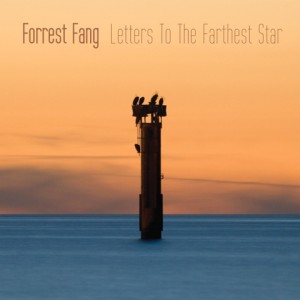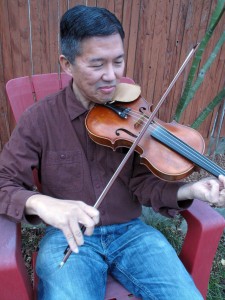Forrest Fang Fantasy Global Orchestra
Podcast: Play in new window | Download
Subscribe: RSS
F orrest Fang’s music sounds like it’s made by a global orchestra, but all of it takes place in a bedroom in his home in San Francisco’s East Bay.
orrest Fang’s music sounds like it’s made by a global orchestra, but all of it takes place in a bedroom in his home in San Francisco’s East Bay.
“So I’ve always been a bedroom musician, I mean from the beginning,” he reveals.
When I was in Forrest Fang’s bedroom 15 years ago, I said it was dominated by five computers, synthesizers and recording gear. And that’s still pretty much the case.
“It is to some degree. I still have my DSS1 although now it’s under the bed. I do have company in this house, so she would probably not like the idea of having to wade through piles of instruments to get to the bathroom. That’s why I have some instruments in different parts of the house. But yeah, it’s basically a bedroom studio is what it is.”
Out of that bedroom comes an explosion of surreal, global sounds, a world music ensemble beyond imagination. Forrest Fang has been recording since his first cassette in 1980 and for the last 35 years, he’s been creating ambient world music soundscapes using western instruments like the violin and synthesizer, eastern instruments like the gu cheng and dan bau, gardening instruments like flowerpots and toy instruments like the Marxolin. His albums range from folkloric to deep space. Earlier this year he released an ambitious new CD that may be his most fully realized album yet. It’s called Letters to the Farthest Star.
He was trained as a violinist but Fang started to veer away when he began hearing minimalist composers.
“The strongest influence when I started as a musician is being very, very influenced by the three major pillars of minimalism — Steve Reich, Philip Glass and Terry Riley,” he says. “In fact, my second album, Some Brighter Stars, was completely created using tape delays.”
In the mid 1980s, Fang began exploring his Chinese roots and studied the gu cheng, a Chinese zither similar to the Japanese koto. This set him on a world music path that continues today. Sitting on his bed, Fang is surrounded by instruments.
 “Well, I have my cheng, which takes up about the length of the bed,” he laughs. “It’s just a very big instrument, There’s my mandolin. I have a Japanese palm harp. I have the baglama. I have my cumbus which is on another piece on that album, ‘Burnt Offerings.’”
“Well, I have my cheng, which takes up about the length of the bed,” he laughs. “It’s just a very big instrument, There’s my mandolin. I have a Japanese palm harp. I have the baglama. I have my cumbus which is on another piece on that album, ‘Burnt Offerings.’”
As you can tell, many of his instruments come from other countries, like the South American Banduria.
“I came across this when I was living in San Francisco in the ‘80s. Paid $7 for it at a garage sale,” Fang laughs.
It’s usually played like a guitar, but Fang plays it with mallets. “Then I have two pencils here,” he says, demonstrating the technique. “So it really sounds more like a hammered dulcimer the way I’m playing it, but I just love the overtones you get from the instrument. I make no bones about the fact I’m not playing it traditionally. I’m not native Peruvian and I don’t make any pretentions of being one.”
Then there are the instruments that are as fanciful as his music like the Marxolin, one of many instruments from the Marx Colony, designed for pure amateurs to play.
“It’s a one-stringed instrument. It’s a one of a kind thing. It’s got a body like a balalaika, and a string that just runs across the top like an erhu, and it’s got this weird metal slide. It’s built right into the strings so I don’t know what happens if a string breaks. You can basically bend the thing. It’s just like a whammy bar, but it’s just the craziest sounding thing. Like a Warner Bros. cartoon effect or something, you know, Quick Draw McGraw.”
Along with cumbus, baglamas, Kenyan flute, saron and a host of other instruments, the Marxolin makes up Forrest Fang’s global music orchestra from the other side of dreams. Virtually everything on Letter to the Farthest Star is hand played.
“I was trying to avoid sounding like the pieces were machine driven,” he reveals. “I mean everything was played by hand.” Except for those things created by computers. On a track called “Veldt Hypnosis” it sounds like an African drum ensemble. Ironically, that came from a computer program.
“The basis of that kind of the exotic mbira, xylophonic type of African sound really came from Yan Terrien who wrote the algorithm for the “Katorzer” program. It was developed in the mid ‘90s when I was really into fractal music. And he developed these really crazy programs where you basically throw in–what looked like trigonometry or algebra, he had these long equations and he would insert numbers and rough parameters, and you get these really crazy movements that that were really non-linear, not tied to any meter, nothing. And it just sounded so fascinating, and believe it or not, the xylophone part for that was generated on this program,” Fang explains.
Forrest Fang has been at the furthest edges of instrumental exotica, but on Letter to the Farthest Star he returns to his original instrument, the violin, playing it more than he has on any previous album.
“Early in my career I made more of a conscious attempt to not play it so much because I thought it was a bit of a crutch,” he confesses. I thought it would be more challenging to play these other instruments that I couldn’t play, even though I don’t have nearly the technical ability on these other instruments. I could find something interesting to say, you know, maybe like a little 2-3 minute segment or something that I could use somewhere.”
Forrest Fang’s Letter to the Farthest Star is a return to melody for this sonic explorer who has made albums that even he said were “kind of like commercial suicide maybe, I don’t know…I’d forgotten how much I missed hearing melody in acoustic instruments, in particular. I’d gotten away ffrom just purely melodic music. And it wasn’t by any design. It was just a process that I was following at the time. And I thought well, this seems like as good a time as any to try to do something that really consolidates a lot of different things I’ve done, and yet put a current twist on it so I’m not just rehashing old methods and really try to make a statement that speaks for the past and present.”
The past and present exist in the singularity of Forrest Fang’s timeless music. His latest album is Letter to the Farthest Star on Projekt Records.
~John Diliberto
